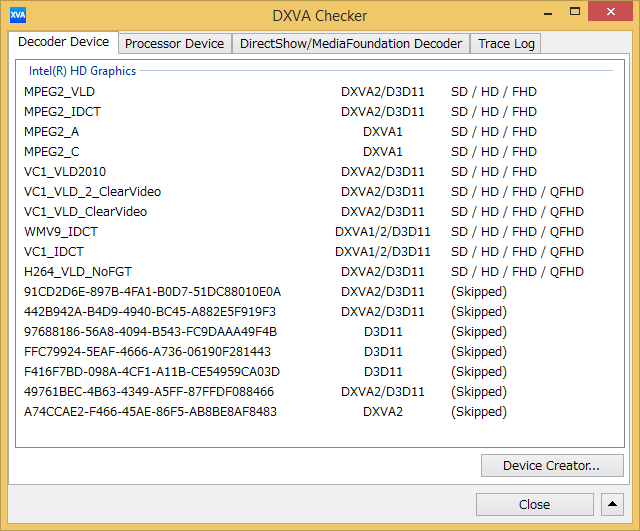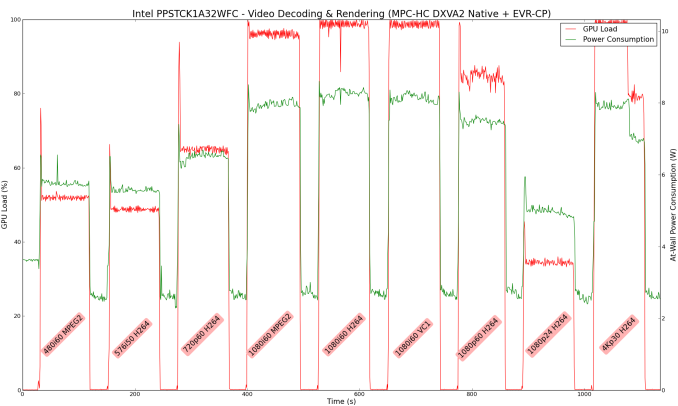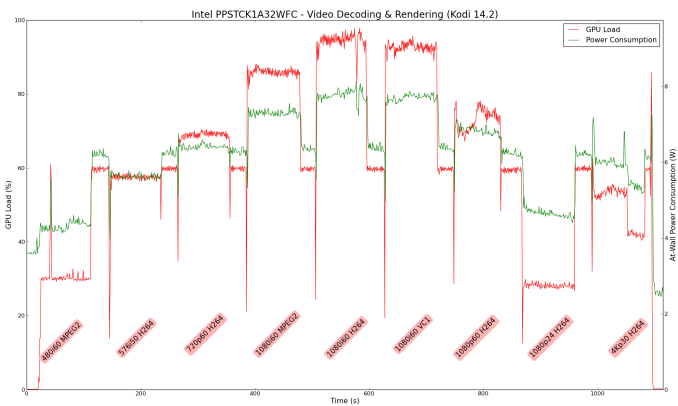Intel PPSTCK1A32WFC Bay Trail-T Compute Stick Review
by Ganesh T S on April 22, 2015 11:00 AM EST- Posted in
- Systems
- Intel
- Bay Trail
- HDMI Stick
HTPC Credentials
Usage of the Compute Stick as an entertainment platform is promoted by Intel as one of the use-cases. It is a bit surprising (given the form factor) that the Compute Stick has a fan. Subjectively, I was not comfortable with the acoustics in a 'office scenario' with the Compute Stick at the base of the monitor (connected via the HDMI extender cable) and myself seated around 70 cms. from it. The small diameter of the fan makes for a whining high-pitched noise, and it is compounded by the fact that it starts and stops depending on the SoC load.
Objectively speaking, Intel provided an acoustics rating of 28 dB at 1m distance for the noisiest mode. If the Compute Stick were to be hidden behind the TV, it is unlikely that users can hear such low noise at typical television viewing distances. It is not ideal, but Intel indicated that the performance of the device needs proper thermals. In order to to balance the very small size along with overall cost and performance, they went with a small fan as the optimal thermal solution. Now that we have got the acoustics out of the way, let us move on to the other HTPC aspects.
Refresh Rate Accurancy
Starting with Haswell, Intel, AMD and NVIDIA have been on par with respect to display refresh rate accuracy. The most important refresh rate for videophiles is obviously 23.976 Hz (the 23 Hz setting). The Intel PPSTCK1A32WFC has no trouble with refreshing the display appropriately in this setting, but it is not as accurate as Haswell or Broadwell or even other Bay Trail-based systems (refreshing at 23.973 Hz instead of 23.976 Hz).
The gallery below presents some of the other refresh rates that we tested out. The first statistic in madVR's OSD indicates the display refresh rate.
Network Streaming Efficiency
Evaluation of OTT playback efficiency was done by playing back our standard YouTube test stream and five minutes from our standard Netflix test title. Using HTML5, the YouTube stream plays back a 720p encoding. Since YouTube now defaults to HTML5 for video playback, we have stopped evaluating Adobe Flash acceleration. Note that only NVIDIA exposes GPU and VPU loads separately. Both Intel and AMD bundle the decoder load along with the GPU load. The following two graphs show the power consumption at the wall for playback of the HTML5 stream in Mozilla Firefox (v 37.0.1).

GPU load was around 51.56% for the YouTube HTML5 stream and 4.53% for the steady state 6 Mbps Netflix streaming case. Mozilla Firefox is terribly inefficient in terms of power for YouTube playback. The same test stream, when played back in Internet Explorer, consumed only 3.55 W on an average and had a GPU load of 9.1% for the same H.264 stream.
Netflix streaming evaluation was done using the Windows 8.1 Netflix app. Manual stream selection is available (Ctrl-Alt-Shift-S) and debug information / statistics can also be viewed (Ctrl-Alt-Shift-D). Statistics collected for the YouTube streaming experiment were also collected here. The power efficiency of the Compute Stick platform comes to the fore here.

Decoding and Rendering Benchmarks
The form factor of the Compute Stick and the internal components make it clear that consumers are not going to play back videos using the madVR renderer. Instead, it is highly likely that Kodi will be used as the interface for media playback. We evaluated performance under MPC-HC + EVR-CP and Kodi 14.2 for our test suite. Prior to those results, let us take a look at the codecs that are hardware-accelerated by the Bay Trail-T SoC.
As expected, we have acceleration for MPEG-2, VC1, WMV9 and H.264. HEVC is not necessary for such a platform at this point in time.
In our earlier reviews, we focused on presenting the GPU loading and power consumption at the wall in a table (with problematic streams in bold). Starting with the Broadwell NUC review, we decided to represent the GPU load and power consumption in a graph with dual Y-axes. Nine different test streams of 90 seconds each were played back with a gap of 30 seconds between each of them. The characteristics of each stream are annotated at the bottom of the graph. Note that the GPU usage is graphed in red and needs to be considered against the left axis, while the at-wall power consumption is graphed in green and needs to be considered against the right axis.
Frame drops are evident whenever the GPU load consistently stays above the 85 - 90% mark. In addition to tracking that aspect in the graphs below, we also get an idea of the system's power efficiency for decode and playback of some common codecs.
The above graph suggests that the Compute Stick is likely to drop frames when deinterlacing of high frame rate content is required. It is possible that EVR, the native renderer, will perform better than EVR-CP.
Kodi doesn't deinterlace content by default - so, the GPU load goes unreasonably high only for the 1080i60 stream. Another aspect to observe with Kodi is that 'idling' at the XBMC interface consumes around 60% of the GPU resources and the power penalty is around 6 W. Depending on the codec and frame rate, the GPU load and power consumption might be lower or higher than the 'idle' state. For example, 480i60 and 1080p24 videos play back within the 5 W power envelop.
Note on HD Audio Bitstreaming
As of April 2015, the Intel graphics drivers for Bay Trail-T (32-bit) have support only for bitstreaming of DTS, Dolby Digital and Dolby Digital Plus. This means that Netflix and other similar OTT sites are in the clear. However, users hoping to take advantage of lossless HD audio in Blu-ray backups are going to be disappointed. In any case, streaming of Blu-rays over a 802.11n Wi-Fi network will result in a bad user experience. So, it is possible that the absence of HD audio bitstreaming will not bother too many consumers.



















103 Comments
View All Comments
Deelron - Wednesday, April 22, 2015 - link
Pretty much this, plus if you're already invested in a moderate sized or greater NAS solution, it seems like it'd be pretty cost efficient to just step up to a low priced NUC anyway, unless the form factor of a large stick out the back of the TV is absolutely critical.zeo - Sunday, April 26, 2015 - link
Unless your device is using one of a few select Celeron branded Bay Trail's then it does support Quick Sync... Bay Trail uses a Gen 7 (Ivy Bridge) GPU that's just scaled down to 4EU's and slower clock for mobile usage but still supports features like Quick Sync...joex4444 - Wednesday, April 22, 2015 - link
Running a 1Gbe connection over 480Mbps USB 2.0 is inherently going to limit you. Still better than the 50Mbps or so you *might* get over the 802.11n, but really... running a CAT5 cable out to your TV is bordering on the non-trivial. Even if feasible it's not clean.nathanddrews - Thursday, April 23, 2015 - link
It's no more complicated than any other cable and is every bit as clean. I bought this http://amzn.com/B005LW4CFG a few years ago and it has made it trivial to run all my cables (HDMI, speaker wire, networking) through walls. Very feasible and clean.As for the 1GbE connection over USB 2.0 - it is slower than real GbE - but the gains in latency and throughput make it possible to stream so much more than the weak wifi permits. It's worth doing.
Hulk - Wednesday, April 22, 2015 - link
This is an interesting idea but for me there are too many limitations for me to consider it. Now at 10nm with a lower power x86 2/4 processor and 120GB of controller based storage I'd be interested as a HTPC or computer for my kids.jjj - Wednesday, April 22, 2015 - link
So a SoC that due it's perf is worth 5$ , the NAND+RAM are less than 25$, the wifi must be 3$ or less and all in all 150$ is way too much. Damn x86 monopoly.Refuge - Wednesday, April 22, 2015 - link
You can bet a lot of it is probably licensing for Windows 8.1. This isn't Windows with Bing.Lonyo - Wednesday, April 22, 2015 - link
The WIndows license is $40. The Ubuntu version is $110 vs $150 for the Windows 8.1 version.ganeshts - Wednesday, April 22, 2015 - link
Note that there is 24 GB of extra eMMC for the Win 8.1 version.BMNify - Wednesday, April 22, 2015 - link
Ubuntu version is cheaper because it has just 1GB of ram and 8GB storage, Windows 8.1 version has 2GB ram and 32GB of storage.